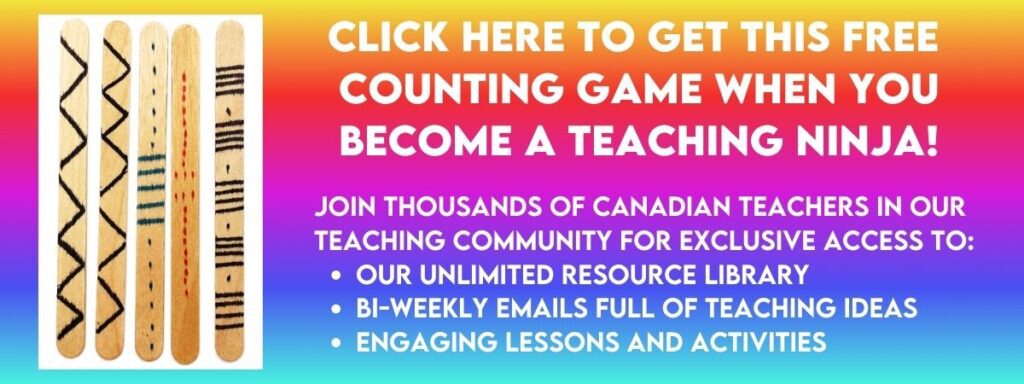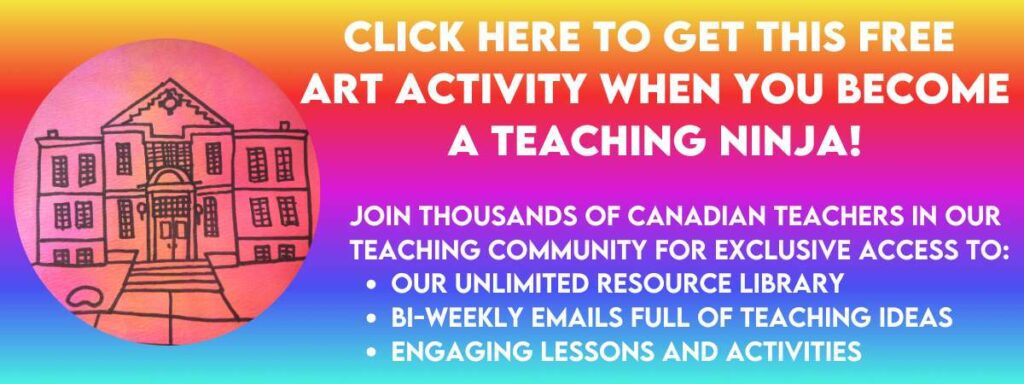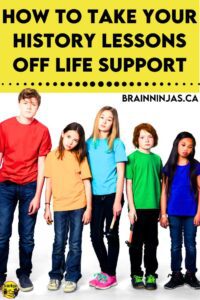
If you’ve ever thought your history lessons were boring, then truthfully, you had the wrong teacher. Teaching history can be exciting and interesting.
My love of Canadian history came from my favourite teacher of all time, Mr. Perrin. He was a tough teacher who expected the best from everyone, but he had a way of bringing history alive. You felt like you were in the trenches of World War 1 or at the table of a family living through The Great Depression. I underestimated the impact this love of history would have on my life.
Each time I step into my classroom and stand up in front of my students to tell them about some historic event, I still see Mr. Perrin jumping from side to side, role-playing both the French and the Germans in battle. This love of history was so apparent I can’t help but pass this enthusiasm along to my students.
Teaching History Has Changed
As history becomes more and more complicated, it’s even more important to inspire your students to learn as much as they can. After all, if we don’t learn from the past, we are all doomed to repeat it. There is a famous quote in there somewhere, either attributed to George Santayana or Sir Winston Churchill.
How we were taught history in the past has changed. The textbooks that were rolled out by the millions are now questioned for their bias. We now have a better understanding of how our bias plays a role in how events are viewed.
We better understand how colonialism has impacted our learning (or lack of learning) about the Indigenous People. We’ve learned that even though we as Canadians think of ourselves as a group of people who have been tolerant and loving of everyone, there are places in our history that are not so admirable.
Textbooks are no longer the sole source of information. The internet has revolutionized how we find information, but that also means we need to teach students to look at all that information critically without taking it at face value. We need to consider the point of view and the author’s intent.
We love to bring this history to life for our students, but it is essential to think about how this happens so the context or importance of the lesson doesn’t get caught in a game or art project.
Frankly, we’ve made mistakes in our classrooms over the years, but after learning more, we did much better and so we’re hoping we can pass some of that information along to you. You can’t get better until you acknowledge the mistakes you’ve made.
Don’t Sugar Coat It
History has some pretty dark parts and while we don’t want to terrify young students, we also don’t want to glaze over the dark and scary parts as if they didn’t happen.
We had an amazing conversation one afternoon about the Holocaust. By amazing, I mean all the students were asking thoughtful questions and their curiosity was genuine. They wanted to know how the world could just stand by and let it happen. This led to a discussion about the causes of the Second World War. These students were in Grade Five, so it was important to be honest without being too graphic.
Children only ask questions they want to hear the answers to. It’s important to be honest but careful. And not all classes will want all the details. This is why knowing your students is important.
If we don’t talk about the dark and scary parts, our children will grow up not really understanding these events.
Games Have a Place-But Be Careful
You can liven up a part of history with a game, but be very careful that the game is in the right place. Playing a game about slavery-absolutely not. Playing a game to show how the stock market crashed before the Great Depression-sure.
The topic needs careful consideration. Reach out to other teachers, community members or friends. If they are not giving you a resounding “that sounds like a good idea,” then it’s not a good idea. When in doubt, don’t do it.
Learning games from different countries is one way to learn about different cultures. Try the Bone Game, played by Indigenous children in Canada to learn to count. You can find it in our Resource Library, or we can send it to you when you sign up for our email list.
Role-Playing Has a Purpose
Getting your students to act out important events or historical figures can be a great way for them to engage with the information, but you need to have a talk with everyone involved about cultural appropriation, cultural stereotypes and how to be respectful of how these figures are portrayed.

Just like if you were trying to decide if you should play a game to help learn about a topic, person or event, you have to be careful with the role-playing.
Role-playing also needs parameters so students have a specific task to accomplish. For example, in our resource The Canadian Puzzle: Explore Canada’s Diversity Prior to Confederation reading passages, there are several groups of people who lived in Canada before confederation. Students were put into small groups and assigned one passage. Their job was to teach the class about the contributions of the group of people.
By having a specific task, students were less likely to make up random information or fall into stereotypes. As a teacher, my role was to preview the presentation before it was shown to the class. This way I could redirect any misinformation or recommend emphasizing certain contributions that would be considered more important than others.
Find The Canadian Puzzle: Explore Canada’s Diversity Prior to Confederation in our TpT Store ($USD) and BN Shop ($CAN). The students love the activities and the teachers we’ve talked to who’ve used it feel like it saved them a ton of time finding reading material at the grade four or five level.
We also have some role-playing in our Immigration to Canada After Confederation, where students get the chance to learn about some of the different communities created through immigration. Find it in our TpT Store ($USD) or BN Shop ($CAN).
Present Both Sides
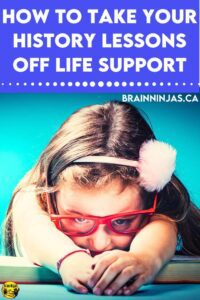
If you are going to talk about how the explorers “discovered” the new lands, then it is also important to talk about how the Indigenous People felt as the settlers and colonists arrived.
If you are going to talk about the fur trade, you should present the information from the perspective of both the fur traders and the Indigenous People who worked for or were against the fur trading companies.
Your role as the history teacher is to present the facts from both sides of the event or issue and then let your students develop their own opinions.
We find that so often, students look at issues as black or white. They don’t seem to appreciate the finer shades and complexities in between. This is one of the reasons we wrote a resource that asks students to look at all the facets of a complicated issue.
Pipelines are a current event that often dominates new reports in Canada these days. The battle over fossil fuels and climate change often becomes heated arguments and so it’s difficult to teach students how to respectfully disagree, but more importantly, how to learn the facts of a case before making a decision or forming an opinion about the matter.
In The Pipeline Perspective, students learn a whole bunch of different facts about fossil fuels, pipelines, the economy and the climate. These facts are discussed in a non-biased way (meaning they do not lean one way or the other), and students work through various activities to help them develop an opinion about whether or not a pipeline is the best method to move oil or natural glass. Find The Pipeline Perspective: Multiple Perspectives Activity in our TpT Store ($USD) or BN Shop ($CAN).
Use Art Activities
The final art project in our Natural Resources package looks at understanding the natural resources of a particular area, region, country, province or state. Students complete several activities to learn about and appreciate different natural resources. Find Natural Resources Lessons and Activities in our TpT Store ($USD) or BN Shop ($CAN).
Have students create comic strips to retell the events of history. This is a great alternative to timelines can be tricky for students.
We also look at geography and think about ways we can incorporate drawing into our social studies class. This is exactly what we accomplished with our Geography and Landscapes Art Lessons. These lessons are designed for elementary generalists who teach art in their own classrooms. Find them in our TpT Store ($USD) or BN Shop ($CAN).
Project Based Learning=High Engagement
If you’ve never done any project-based learning, then we recommend reading our post The Reasons for Project-Based Learning.
When we use this teaching method, we give our students a little taste of the topic with exciting activities and then set them free to discover everything else on their own.
For example, when we are about to start our Canadian fur trade unit, we start by taking our students on a canoe ride. We teach them a simple song which we’ve listed below under the music section and line up all the chairs so that we form a canoe shape. We use meter sticks as paddles, sit in our boat, and sing.
Then we portage.
This is the fun part for us. We tell the students to pick up everything and we haul it to another place in the school (sometimes we’ve made arrangements to visit other classrooms). We set the canoe back up and paddle while we sing again.
And then we do this again and again.
And again, until we notice they’re tired.
Then we return to the classroom and debrief about how difficult our “portaging” was. We talk about some of the other challenges the fur traders would have experienced (like black flies, bears and rapids). We talk about how important the local Indigenous People were to the survival of the fur traders.
Projects About Early Canada
Design a Fur Trading Post can be used as part of a unit about Early Canada. Find it in our TpT Store ($USD) or BN Shop ($CAN). Students are asked to be archaeologists and explain what life was like for the people who lived at or near a fur trading post during this time.
We also have Design a Prairie Homestead in our TpT Store ($USD) or BN Shop ($CAN). which works well for learning about colonization of the prairies. It begins with activities to learn about the local Indigenous People and how colonization impacted them. Students also learn about the natural materials available and the needs of people living in the area.
Design an Indigenous Shelter. in our TpT Store ($USD) or BN Shop ($CAN) encourages students to look at different shelters used historically by different First Nations, Métis and Inuit. Students create a museum display to educate others about what they have learned.
Don’t Forget the Music
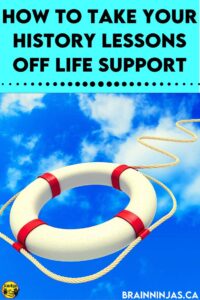
Music is an important part of our culture and it’s woven throughout history. If you’re not comfortable singing with your students, consult with your school’s music teacher or find songs on YouTube.
When we were learning about the Canadian fur trade, we learned some of the songs that the voyageurs sang in the canoes as they paddled on the rivers. Search for J’entends le moulin or En roulant ma boule as these are great paddling songs to learn.
If you’re learning about the Underground Railroad, Follow the Drinking Gourd is a song with historical context that is worth teaching your students. In fact, many of the gospel songs were directions and communications between the enslaved people who were trying to escape to freedom.
Song lyrics throughout history were used to tell the tales of historical events. Stompin’ Tom Connors often wrote ballads about different Canadian events. Using his song lyrics, students can search for the facts about the events he wrote about.
Be Passionate About Social Studies
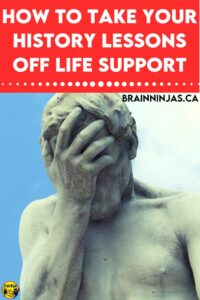
Your positivity about learning history will be contagious to your students, but so will a negative attitude. Your students will want to learn if you enjoy teaching it. And if you don’t enjoy teaching history, fake it until you make it.
Yes, history is very complex and full of details and dates, but honestly, your students aren’t going to remember the little details that can be found online. They’re going to remember your passion for the subject. Every time they learn about something, they’re going to remember how wonderful you made their learning.
And if they ever become teachers themselves, they’ll want to be just as amazing as you.
What are some of the ways you bring social studies or history to life for your students? We want to hear about it.

